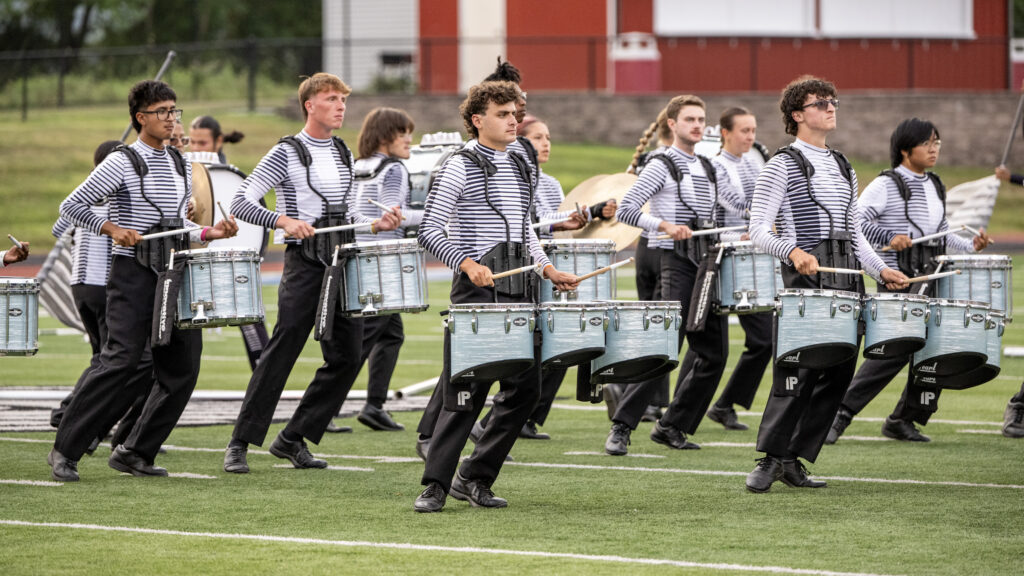The knowledge we now have about the need for protection from the sun is quite different from the knowledge we had when I marched in a drum corps in the mid-1970s. We are much more educated now about the dangers of the sun that can come back to haunt us years later and we don’t feel so self-conscious now about lathering on the sunscreen.
An ounce of prevention (or several ounces of it) is worth a pound of cure. Or rather, several skin melanomas and resultant doctors’ visits.
Fellow DCI.org columnist Emily Tannert, who recently wrote an article about being safe in the sun, sent me the following contribution from Brian Miller, which arrived too late for her article.
When someone gets sunburn, you can use a bunch of tea bags with lukewarm water. Soak a washcloth in it and put it on parts of the body that hurt. That helps take out the sting of the burn.
I had never heard of that and it certainly is worth a try if one gets sunburn. But of course, it is preferable to avoid getting sunburn if one can..
Gene “Gino” Garrett is a veteran of Vaqueros, Guardsmen and Madison Scouts.
You know what’s funny about this? (Okay, it’s not so funny anymore.) Back in the 1970s it was almost desirable to get sunburned to start off the season, and it was certainly expected. Once we started learning the drill outside around April, it was a given that we would spend the day out in the ever-warming sun. We were all “winterized” from months out of the sun, and then “boom,” we were right out in the sun during the first few nice weekends of spring. It wasn’t a problem for me as a kid, at least at the time, but the real trouble was not to present itself for many, many years. I’ve been lucky enough to have only had minor skin concerns all these years later, but I was given a wake up call when I got the chicken pox as a 28-year-old. When you get chicken pox as an adult, the pox themselves last much longer than when a kid gets them. I decided to see a dermatologist about my pox, and his advice to me came as quite a shock: Stay out of the sun for two full years, maybe three. Holy cow! At the time I lived in Southern California! This was going to be impossible for me, especially since I loved the beach! We started talking about my drum corps years and the obligatory spring burn I would get every year, and he was very concerned about that. He told me that the trauma I was putting my skin through would be basically the equivalent of having second-degree burns, and for me to go back outside the next day would just compound the damage. My yearly ritual of peeling skin and finally getting a tan was actually like signing a contract to the effect of “play now, pay later.” What awaits me is an undetermined future of skin melanomas and liver spots that may be of concern, especially on my nose and upper cheeks, as well as the back of my hands and my shoulder areas. Now every time something starts to show itself, I rush off to have it looked at. My nose gets badly burned if I’m not careful. I can remember it being blistered in 1982 when I was in the Madison Scouts, and I basically just let it heal itself up with no real treatment or continued protection beyond that. Yikes! I did heal up properly, but some of the more pronounced pockmarks have left small scars that do not tan, so I get a few white dots on my skin where the pockmarks were. I was lucky, really, because I had quite a case of them. But more important was the impression I got from my dermatologist. He practiced in Southern California and was really an advocate of not laying out in the sun. I found out late that the repeated sunburn I would get every year when I was 16, 17, etc. would come back to haunt me in my 40s, 50s and 60s.
Evan Kleve of Bluecoats and Brigadiers sent me this e-mail hoping more drum corps members would learn from his experience.
2001 was my rookie year in Drum Corps International, and I was extremely stupid. I am extremely white and I didn’t know I was even capable of tanning, so I wore a shirt at rehearsal during the first two or three weeks of tour. Eventually, I got tired of being the polar opposite color from everybody else in the corps, so I decided to use logic (and by “logic,” I mean stupidity). We were in Iowa for a rehearsal day and there wasn’t a cloud in the sky. I decided that if I just spent a two-hour rehearsal block in the sun with no shirt and no sunscreen, I would magically become tan. How could I have been so stupid? I got the worst sunburn you have ever seen in your life. That night I could tell I had done some damage, but nothing was too visible yet. The next day I was in severe pain and there were so many blisters that my back and shoulders looked like bubble wrap. I was in so much pain that I could not stand still during rehearsal. I was shaking from the physical agony. That is the only time since I was a little kid that I can remember crying because of pain. I was extremely lucky that we had three days without a show because there is no way I would have been able to wear the uniform. I would have missed a show and that would have killed me. To this day, I have permanent scars on my back from that fateful sunburn. It serves as a reminder. I finished two years in DCI and never wore a shirt during rehearsal, as I could not stand wearing a shirt while rehearsing. But I always applied sunscreen beforehand! For you junior corps kids, no matter how much sunscreen you wear, you will still get a wicked tan. Last year in the Brigadiers, fellow marchers light-heartedly teased me because I wore strong sunscreen and remained almost as white as when I started the season. But being white is far better than revisiting the agony that I experienced in 2001. Never underestimate the sun!
Barbara Wendt played in the Governiers and is currently a member of Gulf Coast Sound.
My very first drum corps camp was with the St. Peter Governiers on a cool April day. I wore shorts and a sweatshirt and played a xylophone for most of the day with the sun at my back. It was only 50 to 60 degrees outside, so I did not think of sunscreen at all. (In Minnesota, it was kind of a three months out of the year thing). The back of my legs burned so bad on that cool day, that I had blisters for weeks. I had to wear pants for practice for the rest of the season to protect them, and the scratchy uniform pants really aggravated me for weeks. It is easy to remember sunscreen on days when it is in the triple digits, but the sun can also do damage during cool and cloudy days.
I’d like to end with a contribution from David Curley, a former member of Boston Crusaders and an MD PhD Student at the University of Vermont College of Medicine. He is specializing in the effects of sunburn. In fact, his thesis project is titled “Conditional Mouse Models of Malignant Melanoma.”
There will be an estimated 55,000 new cases and nearly 8,000 people will die this year in the United States of malignant melanoma, the most deadly form of skin cancer. People in the United States can expect to have a 1:71 lifetime risk of getting melanoma. When melanoma is caught early, the expected 10-year survival is well over 90 percent. However, the 10-year survival for stage IV melanoma is less than 10 percent. Although melanoma has the highest mortality among skin cancers, basal cell and squamous cell carcinomas can cause significant problems for patients. There are nearly 1.3 million new cases of these two types of skin cancer each year in the United States. Although fewer people die each year of squamous cell and basal cell carcinomas than do of melanoma, many recur several times, requiring significant amounts of surgery that leave them scarred and with other health problems. In rare instances, these basal cell and squamous cell carcinomas can also be fatal. The most important risk factor for all types of skin cancer is the exposure to UV radiation. The major source of UV exposure is sunlight. By far, the best way to avoid skin damage/cancer is to limit exposure to the sun. It is a myth that tanning decreases the risk of long-term skin damage. In fact, tanning greatly increases the cumulative effects of UV exposure. Avoiding sun damage can best be accomplished by wearing clothing that covers as much exposed skin as possible. This includes wearing hats with wide brims. People should also apply a high quality sun block several times a day that provides protection against both UVA and UVB. Some good ingredients to look for are parsol 1789 (avobenzone), oxybenzone, zinc oxide or titanium dioxide. Some general rules of thumb are that you should put it on 15-20 minutes before going out into the sun, using at least SPF 15. Also, most sun blocks need to be reapplied at least every three hours. If you are sweating excessively, as most of us do when marching around a football field in the middle of the summer, it needs to be applied even more often. The incidence of melanoma is increasing in nearly every Caucasian population in the world. Although historically low, it is also increasing in other populations such as Hispanics and the Japanese. While people with fair skin and hair are at the greatest risk for melanoma, people with dark skin also need to be wary of excessive sun exposure. Bob Marley died at only 36 years of age of a melanoma that was initially on his toe and spread to his brain and lungs. Although prevention is the best way to avoid problems with skin cancer, early detection is the key to decreasing mortality. Examine your skin and remember “A-B-C-D.” If you notice anything that is Asymmetric in shape, has irregular Borders, has unusual Coloring, or has a large Diameter (bigger than a pencil eraser) on your skin, you should show it to your doctor. Protect your skin and have a great summer.
Michael Boo has been involved with drum and bugle corps since 1975, when he marched his first of three seasons with the Cavaliers.
He has a bachelor’s degree in music education and a master’s degree in music theory and composition.
He has written about the drum corps activity for over a quarter century for publications such as Drum Corps World, and presently is involved in a variety of projects for Drum Corps International, including souvenir program books, CD liner notes, DCI Update and Web articles, and other endeavors.
Michael currently writes music for a variety of idioms, is a church handbell and vocal choir director, an assistant director of a community band, and a licensed Realtor in the state of Indiana. His other writing projects are for numerous publications, and he has published an honors-winning book on the history of figure skating.
His hobbies include TaeKwonDo and hiking the Indiana Dunes.
But more than anything, Michael is proud to love drum corps and to be a part of the activity in some small way, chronicling various facets of each season for the enjoyment of others.
Jean Cartwright from Novi, Mich. contributed the following about “goodie bags.” It sounds like a great idea that more should pick up on.
Goodie bags
Our son was part of a Division III corps the summer after he graduated from high school in 2004. He marched all four years in high school and played all four years in a competitive winter drum line, so he kind of knew what was expected in going to a corps. He is about six feet tall and weighs about 140 pounds. I was told the kids could expect to lose weight on tour, but my son just didn’t have anything to lose, so the goodie bags came about on my attempts to get my son to eat more. I brought my son’s favorite cookies (butterscotch oatmeal) and a large bag of homemade Rice Krispies treats for the drum line bus to the Toledo show, the first show we went to that season. The kids were pretty happy to see treats. Next we saw them in Canton, Mich., and we brought two large trays for the entire corps, with watermelon, cantaloupe, grapes, strawberries and a goodie bag for my son. It was kind of small, and had beef jerky, nuts, raisins, Tootsie Roll pops, mints and other food. He said it was gone in two days. We drove down to Lima, Ohio with homemade blueberry muffins for the entire corps a week later. We got the tour director’s permission to meet up with them in Chicago the following week to do two meals for them over the Fourth of July. At our own expense, we provided a complete spaghetti dinner before the show, and on the morning of the Fourth of July—before the parades—a hot breakfast of ham, hash browns and more muffins. We just didn’t see any other parents volunteering to do any on-site cooking or traveling with the corps, and had heard that sometimes the staff had to do the cooking. In Kalamazoo, however, we had a huge turnout of family, and as many corps members were from an area nearby, another family hosted a pre-show lunch. We also brought dozens of bagels for them to take on the road. By the time we got to the Centerville, Ohio show, plenty of parents were bringing donations, and we were spending about $100 every time we went out to a show for food for the corps. We got to know the kids individually and knew their special treats. After that, the tour went south and we didn’t see them again until Denver. Sometimes the tour kitchen would feed them and sometimes they were dropped off at the mall to check out the food court. Although my son didn’t tour during the summer of 2005, we went to two big shows to visit all our friends and bring them goodie bags. I would label a large plastic bag with each kid’s name on it and fill it with stuff like pistachios, raisins, granola bars, beef jerky, fruit snacks, Tic-Tacs, string cheese, peanut butter crackers, suckers, animal crackers—just about anything that wouldn’t melt. I also put in a note or card saying how much I enjoyed the show and that I appreciated all the hard work it took to get there. Drum corps is definitely not for everyone, and the dedication to march and play amazes me. I hope the goodie bags bring a small joy into their time on the road.
Michael Boo has been involved with drum and bugle corps since 1975, when he marched his first of three seasons with the Cavaliers.
He has a bachelor’s degree in music education and a master’s degree in music theory and composition.
He has written about the drum corps activity for over a quarter century for publications such as Drum Corps World, and presently is involved in a variety of projects for Drum Corps International, including souvenir program books, CD liner notes, DCI Update and Web articles, and other endeavors.
Michael currently writes music for a variety of idioms, is a church handbell and vocal choir director, an assistant director of a community band, and a licensed Realtor in the state of Indiana. His other writing projects are for numerous publications, and he has published an honors-winning book on the history of figure skating.
His hobbies include TaeKwonDo and hiking the Indiana Dunes.
But more than anything, Michael is proud to love drum corps and to be a part of the activity in some small way, chronicling various facets of each season for the enjoyment of others.





